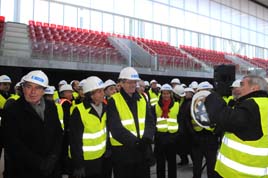The Magic Box enters the home stretch
The mayor visits the construction site, where FCC is hard at work. The facilities will be opened for the first time in May with the men's and women's Tennis Masters Cup.

• The design, by architect Dominique Perrault, blends avant-garde design with versatility and sustainability
• The innovative feature of these three stadiums is their roll-back roofs, which free up the entire playing area and enable the competition to continue even if it rains
• Two of the three stadiums in the Magic Box will be named for Manuel Santana and Arancha Sánchez Vicario
• The purpose behind the new equipment is the same as that of Madrid 16, making Madrid's Olympic candidacy a real possibility
Mayor Alberto Ruiz-Gallardón of Madrid visited the new facilities at the Magic Box, where world tennis stars will be competing in May next. The construction deadlines are being met on what, in the mayor's words, will be one of the "best-equipped athletic facilities in the world by the time it hosts the men's and women's Master Cup, a combined tournament that will definitely strengthen Madrid's standing as one of the major capitals of world tennis".
The mayor was accompanied on his visit by Manolo Santana, manager of Mutua Madrileña Madrid Open, and his association's advisor, Ion Tiriac. He praised the plans by architect Dominique Perrault, who has successfully blended avant-garde design with versatility and sustainability to produce a set of facilities that will be as valued for its functional nature (perfect for the athletic use the complex will be put to) as for its physical appearance, which will enshrine the Magic Box as one of the city's new icons. He also congratulated FCC Construcción on the work it is doing on this project.
Steel, wood and glass
The new facilities, made of steel, wood and glass, consist of two enclosed spaces, the Magic Box and Indoor Tennis, which together have a floor area of over 103,365 metres. The Magic Box holds three roofed stadiums, the players', referees' and press areas and food services. The innovative feature of these three stadiums are their roll-back roofs, which can be recessed to free up the entire area of play, and the fact that the stadiums have a variable seating capacity that ranges from 12,000 in the largest stadium to 3,750 and 2,600 in the other two. Because the roofs can be recessed, three games can be played simultaneously even if it rains.
No other tennis tournament in the world offers such possibilities. Only the Australian Open has a court that can be covered up; the rest are still in the design stage and involve a single court only: Wimbledon has got such a court under construction, while Paris and New York are still weighing the options for their facilities.
During his visit, the mayor announced that two of the Magic Box's stadiums will bear the names of tennis players of acknowledged international prestige, Manuel Santana and Arancha Sánchez Vicario. Their athletic careers, their work to support and promote sport and their solidary attitude are the reasons given for doing them this homage.
The Indoor Tennis section will have 11 indoor courts (five with tiered seating for spectators and six for training) plus other equipment and services related with tennis. Outside another sixteen courts are being built, under the name of "the Tennis Garden". Twelve of these courts will be clay, two will be hard courts and the other two will be grass courts. There will also be plentiful parking.
New life for the surrounding area
"Another thing the Magic Box gives the city is its location, the San Fermín neighbourhood, in Usera. We're on the banks of the Manzanares River, at a site that used to be an environmental wreck. Now it's being transformed into a green space that is recovering the ecosystem of this natural area", declared Ruiz-Gallardón.
Because the Magic Box is in such an advanced stage of construction, Madrid 16 can be said to be no longer a virtual candidacy, but a project that truly has the potential to become reality. This particular complex is part of one of the Olympic project's core areas, the oasis that stretches along the river's length, filling the Manzanares corridor with an array of athletic, cultural and leisure facilities.








